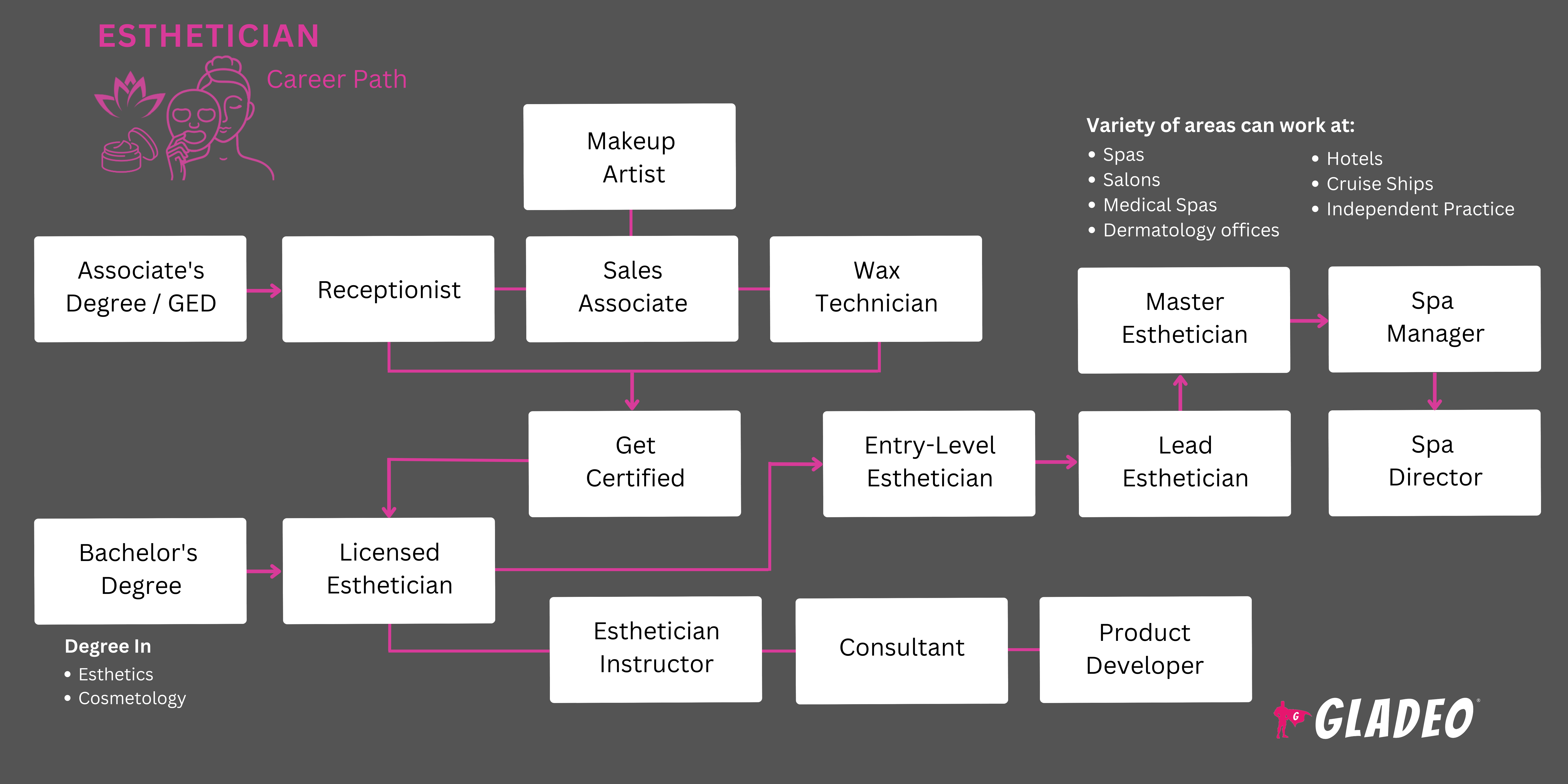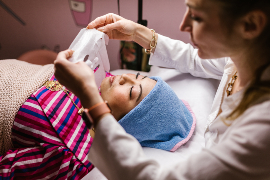Spotlights
Aesthetician, Clinical Esthetician, Esthetician, Facialist, Medical Esthetician, Skin Care Specialist, Skin Care Technician, Skin Care Therapist, Spa Technician
Skin is the human body’s largest organ—and we wear it on the outside!
Well, technically only the top layer, the epidermis, is exposed. The other two layers, the dermis and hypodermis, are usually protected. But each layer is connected, and all three layers can be affected by both internal and external conditions!
Our skin is so complex and subject to so many situations that there’s an entire profession dedicated to skincare. These skin experts are known as Estheticians (sometimes spelled “Aestheticians”). They provide a wide range of specialized services to ensure their clients’ skin is healthy and looks its best.
Estheticians may work in spa or salon settings, wellness centers, or at home providing freelance services. They’re qualified to offer professional suggestions for at-home skincare routines tailored to their clients' unique skin types and conditions. This includes recommendations for products to use or avoid.
Some workers focus on one area of the body, such as cleansing, exfoliating, massaging, and applying masks and treatments to the face. They may also specialize in medical esthetics, working with healthcare providers to offer supportive medical treatments.
- Helping clients look and feel their best
- Aided people with serious skin-related medical conditions
- Learning skills that can be used in a range of settings
- Travel opportunities for specialists working for wealthy clientele
Working Schedule
Estheticians often work flexible schedules with variable hours, including nights, weekends, and holidays. Typical days can vary from relaxed periods to hectic ones.
Typical Duties
- Clean and analyze skin to determine the best course of treatment. Use magnifying lamps or visors as needed
- Provide facial treatments to cleanse, exfoliate, and moisturize the skin, as well as manage complex skin conditions
- Perform extractions to clear clogged pores
- Apply masks, peels, and serums for various skin types and conditions
- Offer consultations to clients, recommending products and daily skincare routines
- Perform body treatments such as wraps, scrubs, and face or body massages
- Conduct hair removal treatments, including waxing, threading, and possibly laser hair removal
- Apply makeup and teach clients makeup application techniques for daily wear or special events
- Adapt treatments according to skin analysis and feedback during the session
- Develop personalized treatment plans to address clients’ specific skincare goals
- Keep records of client treatment plans and progress
Additional Responsibilities
- Stay updated on trends and advancements in skincare and beauty products
- Order and manage inventory of products and supplies. Sell makeup and skincare products
- Build relationships with clients. Encourage repeat appointments
- Educate clients on skin health and protection from environmental damage
- Know about treatment contraindications based on skin conditions or medical history
- Practice proper safety and sanitation protocols. Ensure treatment rooms and equipment are clean and sanitized
- Understand and operate specialized skincare equipment and technology
- Stay current with state licensing requirements. Take continuing education classes, as needed
Soft Skills
- Ability to work independently
- Artistic
- Cooperative
- Customer service
- Dependability
- Empathy
- Endurance to stand on your feet for long periods
- Normal color vision
- Patience
- Steady hands and good hand-eye coordination
- Strong communication skills, including active listening
- Superb attention to detail
- Time management
Technical Skills
- In-depth knowledge of skincare products (and ingredients), techniques, and tools such as:
- Diagnostic and Analysis Tools: Skin Analyzer Machine, Magnifying Lamp
- Exfoliation and Skin Resurfacing Tools: Microdermabrasion Machine, Ultrasonic Skin Scrubber, Dermaplaning Tools
- Hydration and Cleansing Tools: Facial Steamer, HydraFacial Machine, Vacuum Suction Machine
- Treatment Enhancement Tools: High-Frequency Machine, Galvanic Machine, LED Light Therapy Device, Oxygen Facial Machine, Cryotherapy Device
- Regenerative and Anti-aging Tools: Microneedling Pen, Chemical Peel Kits
- Supportive Equipment: Professional Facial Masks and Brushes, Wax Warmers, Electric Massage Tables, Hot Towel Cabinets, Sterilization Equipment.
- Understanding of skin types (normal, dry, oily, combination, sensitive, mature) and conditions, including medical conditions (such as acne, eczema, psoriasis, rosacea, contact dermatitis, vitiligo, seborrheic dermatitis, melanoma)
- Skin histology and the integumentary system
- Familiarity with facial treatments and applications
- Sales and marketing
- Knowledge of contagious skin conditions like impetigo, ringworm, scabies, molluscum contagiosum, herpes simplex, warts, athlete’s foot, chickenpox, and shingles
- Knowledge of dermatological health and hygiene, as well as sanitation and infection control
- Tools and equipment include: Autoclaves, UV Sterilizers, Barbicide Jars, Disinfectant Sprays and Wipes, Ultrasonic Cleaners, Hot Towel Cabinets with UV sterilization, Disposable Gloves, Alcohol and Alcohol Dispensers, Sterilization Pouches, Single-use Implements like spatulas and applicators
- Proficiency with scheduling and client management software
- Personal care service providers (spas, salons, wellness centers)
- Dermatology and plastic surgery offices
- Self-employed/freelance workers
Estheticians are crucial to enhancing and maintaining the appearance and health of their clients’ skin. They’re expected to be knowledgeable, adaptable, and customer service-oriented. Depending on the employer, work schedules may include evenings, weekends, and holidays. In some cases, they may have to deal with demanding or sensitive clients, including those with unique skincare needs or allergies. Practicing good hygiene and sanitation is important to mitigate the spread of germs or contagious skin conditions.
The skincare business is growing fast, with a projected 9% increase in projected jobs through 2032, according to the Bureau of Labor Statistics (BLS). “The projected increase in employment reflects the demand for services being offered, such as mini-sessions (quick facials at a lower cost) and mobile facials (making house calls) directly from skincare specialists rather than hairdressers, hairstylists, and cosmetologists,” BLS writes.
“Employment growth also should result from the desire among many women and a growing number of men who seek out skincare services to reduce the effects of aging, to look good on social media platforms, and to lead a healthier lifestyle through better grooming.”
Most future Estheticians probably enjoyed taking care of their own skin first, keeping it healthy, smooth, and free from blemishes. They may have grown up watching online tutorials or reading glamor magazines and paying attention to the techniques and tools used by their favorite personalities.
Formal Training
- Every state except Connecticut requires Estheticians to pass an exam and get licensed through their respective state’s Board of Cosmetology (or health department), according to EstheticianEDU.org.
- Specific licensing requirements vary by state. Most states require students to complete a formal, state-approved esthetics or cosmetology program. These are usually offered at vocational schools and require between 300 -750 practice hours
- Note, that some high schools allow students to enroll in vocational training programs to prepare for their careers early!
- The American Association of Cosmetology Schools offers a directory of privately owned beauty schools that are association members
Apprenticeships
- Paid apprenticeships are an alternate route to licensure but tend to require more practice hours. Not every state allows licensure through apprenticeship, but several do. These structured training programs allow students to learn directly from an experienced mentor and may take up to a year to complete
- Note, that apprenticeships may incorporate a few classes. The sponsor should pay for these but probably won’t pay students for the time spent in class
- Total apprenticeship hours can vary from 450 to over 2,000, depending on the state
- Apprentices still have to take and pass licensure exams. The sponsor should help to prepare students for the practical exam
Licensure
- In addition to completing training, Estheticians must pass a written and practical exam to obtain licensure
- The written exam covers theoretical knowledge including skin science, facial treatments, sanitation and safety practices, and skin conditions
- The practical exam is a hands-on test where candidates demonstrate skills in esthetic services such as facials, waxing, and sometimes makeup application
- Note, that some states have an additional exam covering state-specific laws
- Once licensed, Estheticians must usually finish continuing education courses to renew their license. For example, Ohio requires 8 hours of continuing education every two years
- Some states, like Washington, feature a two-tier license—a standard and a master license. Temporary or student licenses may also be available
- Many states have esthetician license reciprocity agreements. This means if you get a license to work in one state, another state may grant a license without additional training or testing.
- If you plan to move and work in another state, it’s very important to check with that state’s Board of Cosmetology or health department regarding their current regulations. Don’t make any assumptions, because rules can change!
- Visit the National-Interstate Council of State Boards of Cosmetology and/or the American Association of Cosmetology Schools for more information (including about exams and scholarships!)
- Licensed Estheticians can pursue optional national certification via the National Coalition of Estheticians Association to boost their credentials
- Other optional certifications include the National Council on Laser Certification’s Certified Laser Hair Removal Specialist and Allied Beauty Experts’ Certified Laser Professional
- A college degree isn’t required. Check with your state’s Board of Cosmetology or health department to find an approved training program near you!
- The American Association of Cosmetology Schools offers a directory of beauty schools that are association members
- Programs should have a strong reputation for customer satisfaction. Review their Better Business Bureau profile and Google Business feedback
- Esthetician program costs can vary, so check the total cost including all tuition, books, supplies, and other materials. Don’t forget to look for scholarships, in addition to filling out the Free Application for Federal Student Aid
- Consider if you’d prefer to train via an apprenticeship. These can be competitive since, instead of paying to learn, apprentices receive paid training
- It’s essential for anyone considering an apprenticeship to inquire directly with the program or business offering it, to ask about compensation and expectations. There should usually not be any costs to the apprentice
- High school classes to focus on are biology, anatomy, chemistry, health, and nutrition. Other useful courses may include art, business, psychology, and perhaps home economics
- Some high schools allow students to enroll in vocational training courses. Ask your counselor about any esthetician and cosmetology program opportunities
- Future Estheticians can start learning at home, watching video tutorials, and reading magazines and books
- Learn about different skin tones and characteristics as well as allergies or other possible dermatological reactions to certain products
Decide if you want to apply for an apprenticeship or attend a formal training program at an approved school. Apprenticeships often take longer to finish, but you should get paid for your on-the-job education versus paying for classes. However, if you qualify for financial aid and/or scholarships, you might prefer to take whichever is the shortest route! - You’ll need to craft a customer service-oriented “work persona” and develop your listening and verbal communication skills
- Students can apply to short paid or unpaid internships, which are not the same as apprenticeships but provide valuable work experience
- Start a draft resume early to keep track of the education and experience you acquire

- Create your online portfolio to offer potential employers a glimpse of your work
- Knock out formal training and exams. Obtain your state license (or temporary or student license, if applicable)
- Talk to your program advisor. Some schools have connections with employers and can help you get started
- Be persistent! Reach out to everyone you know who might have a lead on a job, including teachers and classmates
- If doing an apprenticeship, you might end up working for the salon or spa that’s sponsoring you. It may take time to find a suitable apprenticeship, but you can start by looking on Apprenticeships.gov
- List details about your professional work experiences, as well as formal education, volunteerism, and any positive reviews or feedback
- Scan traditional employment portals like Indeed and Glassdoor, but also look on sites such as Craigslist for smaller local opportunities
- Read job posts thoroughly and make sure you meet all the listed qualifications.
- Check out Esthetician resume templates and sample esthetician interview questions (such as “What safety protocols do you follow when performing skin care treatments?”)
- Be enthusiastic and confident during interviews and, of course, dress for interview success!
- An Esthetician’s reputation means a lot! You must treat clients well, earn positive feedback, and establish a solid professional reputation as early as you can
- Build a website (using your professional work name, if the domain is available), get your portfolio seen as much as possible, and consider doing social media tutorials to gain exposure
- Ask a friend in the industry to review your portfolio and offer critical but helpful feedback
- Never take photos of or with clients without their explicit content, and let them know what you intend to do with the images (i.e. if you’re going to add them to your portfolio or post to your business social media pages)
- Strengthen your credentials by taking advanced training courses. Consider pursuing optional national certification via the National Coalition of Estheticians Association
- Learn to market yourself! Establish your professional reputation and make a name for yourself through personal branding!
- Mentor other Estheticians and get involved with professional organizations (see our list of website resources below), workshops, and other events
- Build a strong rapport with everyone you work with and treat them all with respect
Websites
- Aesthetics International Association
- Allurant Medical Spa Blog
- American Association of Cosmetology Schools
- American Massage Therapy Association
- Associated Skin Care Professionals
- Beauty Schools Directory
- Bocaba
- Dr Maryam Zamani
- Institut Dermed
- International Spa Association
- National-Interstate Council of State Boards of Cosmetology
- Professional Beauty Association
- The Aesthetics Advisors
- The Face Space
- The Skin Games
- Your Skin Matters
Books
- How to Make a Million Dollars as an Esthetician: The Secret Formula to Success Revealed!, by D.K. Callahan
- Skincare: The ultimate no-nonsense guide, by Caroline Hirons and HQ
- The Science Behind Skin Care: A Guide for Estheticians, by Kelsey P. Hayden LE
Being an Esthetician is a rewarding career path for many students, but if you’re curious about some related occupations, consider the list below!
- Barbers
- Dental Assistant
- Hairdresser, Hairstylist, and Cosmetologist
- Makeup Artist, Theatrical and Performance
- Manicurist and Pedicurist
- Massage Therapist
- Medical Assistant
- Surgical Assistant
- Surgical Technologist
Newsfeed

Featured Jobs

Online Courses and Tools

Annual Salary Expectations
New workers start around $33K. Median pay is $43K per year. Highly experienced workers can earn around $58K.






